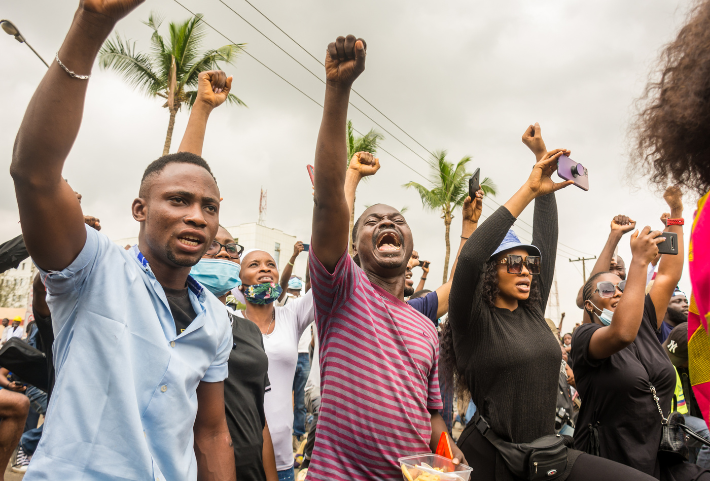By Olunifesi Adekunle Suraj (PhD), Professor, Strategic Communication, Disinformation and Digital Media Literacy, Department of Mass Communication, Faculty of Social Science, University of Lagos
From #ArabSprings (protests and demonstrations across the Middle East and North Africa) to #Musevenimustgo (Uganda), #RejectFinanceBill2024 (Kenya) , #Endsars and the recent #Endbadgovernance (Nigeria), there appears to be no end to demands for accountability and zero tolerance towards bad governance in Africa by determined youths whose main purpose is to effect regime change.
Disappointed by corrupt electoral systems, shrinking civic spaces and ambitious military regimes, African youths appear to have found the needed solace in social media platforms to register their grievances and call for action.

Social media has empowered African youth and vulnerable communities to negotiate their future with those they see as threats to their wellbeing. Digital activism and protests have become a ‘panic template’ used by the African GenZ to reverse unpopular policies.
Fighting for survival
According to British Red Cross, communities in Kenya, Nigeria, Ethiopia, and Somalia are facing the worst food crisis seen in 40 years. The situation appears more pronounced in Sub-Saharan Africa where according to Action Against Hunger’s Report, 264 million people (one out of five people) face hunger.
With food prices having tripled, many citizens can no longer afford three meals per day. For instance in Nigeria, a bag of rice costing around 26,000 naira ($15) in September 2022 was worth 100,000 naira ($60) in October 2024.
A reduction in local food production due to security challenges, high transportation costs due to the removal of an oil subsidy and weakening national currency (due to the floating and devaluation of the naira) as well as high level corruption have culminated in the present economic woes which have left around 84 million Nigerians, representing about 37 per cent of the total population, living below the poverty line.
From suffering to action
The recent #EndBadGovernance protest staged by Nigerian youths tagged “10 days of rage” (August 1–10, 2024) followed by Kenya’s #RejectFinanceBill2024 which witnessed a large-scale digital and physical protest movement, drawing attention to widespread dissatisfaction of various government policies, corruption, economic mismanagement, and social injustice..
The hashtag #EndBadGovernance went viral within hours after it was picked up by social media influencers. It became a top global trending topic for several days as people utilised X’s platform to unify protesters across borders, generating millions of tweets, retweets, and likes. Several Nigerian as well as international celebrities, including notable musicians, actors, activists and athletes, used their social media platforms to support the movement and encourage their followers to engage.
Utilising X’s user base, millions of active participants across Africa and the world posted real-time updates, including meeting points, routes for marches, and safety tips for protesters. The platform’s new features, such as X Spaces (a live-audio feature), were used to host virtual town halls, exchange ideas and discussions, form strategies, and build a sense of solidarity without geographical barriers thereby allowing diverse opinion leaders and influencers to communicate with millions of people across the globe simultaneously.
This helped frame the protest as part of a larger struggle for human rights and good governance. As they gave their opinion, the netizens were able to articulate their #10For10Demands.
Key asks and common grounds
The government was asked to: reduce food costs, address the rising cost of living, curb insecurity across the country, permanently reduce governance cost by 50%, release all #EndSars Protesters, provide security to farmers across the country, increase budgetary allocation to Education and Health care by 20%, sign the new electoral act by December 2024, create immediate employment for youth, clear all backlogs, of pensions, and amend the constitution for a referendum on constitutional and judicial reform.
In exercising their right to protest, the aggrieved youths sought police permission citing their right to protest as a fundamental human right. However, the permission came with stringent conditions as police secured a court injunction to restrict the protesters to certain controlled public spaces while demanding that the protest leaders be held accountable.
The position further heightened the tension with the law enforcement agencies as the protesters ignored the police request.
Disregarding a presidential appeal and police threats, the protest went ahead as scheduled as youth turned out in large numbers to express their grievances, further demonstrating their capabilities to plan organised protest using social media platforms.
The demonstrators took their protest to major cities in Nigeria displaying placards reading: “Enough is Enough,” “Stop Anti-Masses Policies”, “We Are Not Slaves In Our Country”, “Hardship Is Unbearable”, and “Fuel Subsidy Must Be Back”. They were joined by organised labour unions, civil organisations and the Nigerian Bar Association.
Security forces resistance
In some parts of Nigeria, the protest started peacefully but as the movement changed from #EndBadGovernance to #OperationTinubuMustGo, clashes between protesters and police resulted in casualties. By the fourth day of the protest, no fewer than 19 people were reportedly killed as the protest was eventually highjacked by some hoodlums in the northern part of the country resulting in destruction of government properties, vandalization of public infrastructure and massive looting of grocery shops and supermarkets. In another twist, certain youths from Northern extraction begin to display Russian flags.
Despite several arrests and certain demonstrators being wanted by the authorities, including a Nigerian based British national for trying to incite the youth to topple Nigerian government, a new round of protests were planned to coincide with the Nation’s independent day (October 1). Those protests were met with stiff resistance by security forces, indicating that the youths will need to re-strategise their tactical approach in putting pressure on the government.
Pictures from shutterstock.com
Disclaimer:
The views and opinions expressed in this article are solely those of the author and do not reflect the official policy or position of the Media Diversity Institute. Any question or comment should be addressed to [email protected]
